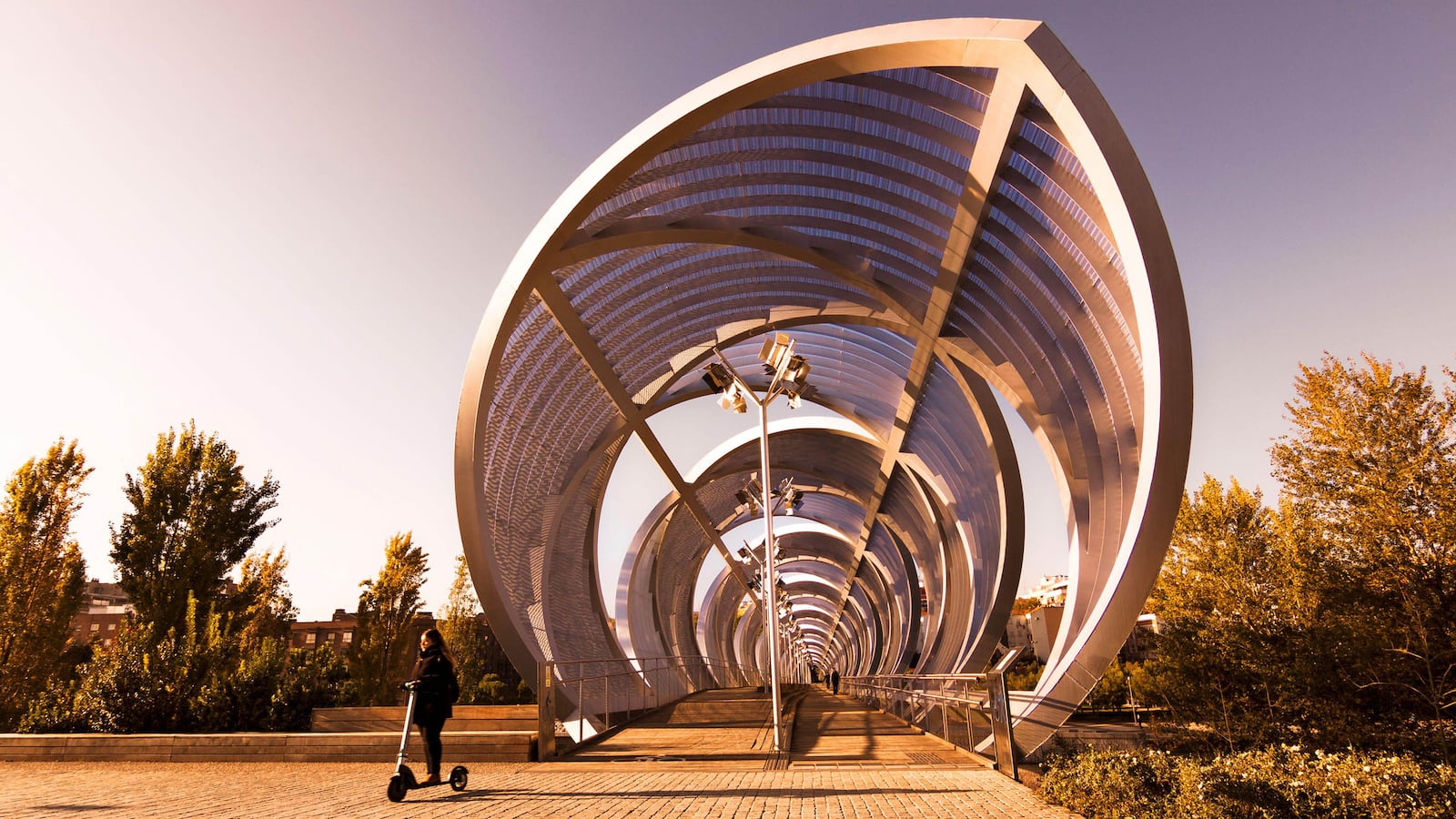This is the latest edition for our twice-a-month series on underrated destinations, It's Still a Big World.
In the last year, many in Madrid have marveled at how peaceful, clean, and livable the city is without its annual influx of 7 million visitors. Museums are spa-silent, restaurant reservations are a cinch, and the Plaza Mayor—the mobbed central square that locals love to hate—is an astonishingly pleasant place for cocktails and coffee. But across the Manzanares River, not much has changed, comparatively: Hardly any tourists ventured there in the first place, and many who live there would just as soon keep it that way.
There are three districts to know south of the Manzanares: Carabanchel, Latina, and Usera, each with its own pulse and personality. Carabanchel, with its scruffy converted warehouses, is a hotbed of fashion and modern art. Latina is an ideal jumping-off point for walks along the Manzanares and hikes in Casa de Campo, a former royal hunting ground that’s six times the size of Central Park. And Usera is one of Europe’s liveliest (and newest) Chinatowns, a tight grid of hilly one-lane streets perfumed with sizzling garlic and fresh-cut cilantro.
Where I live, in the city center, people often knock these barrios, dismissing them as too bland and residential—or, worse, too dirty and dangerous. But that’s mostly hogwash. Like Manhattanites talking smack about Brooklyn or Queens, these urbanites don’t know what they’re missing: a vibrant, unvarnished corner of the city and one of its last un-gentrified frontiers. In other words, a last bastion of Madrid meant for Madrileños.
Here’s the thing: Carabanchel, Usera, and Latina aren’t particularly picturesque. The drab redbrick apartment complexes and brutalist government buildings are a far cry from the charming wrought-iron balconies and cobblestone streets of the centro. That’s because the majority of the real estate is rickety working-class housing built at the behest of a Francoist minister whose tagline was ¡Un país de propietarios, no proletarios! (“A country of homeowners, not proletarians!”). But, hey, you didn’t cross the river for the ‘gram—you came for the culture.
When I wander south of the Manzanares, I make a day of it. A shaded esplanade along the Manzanares stitches together the the three districts, making it feasible to, say, kick back a mid-morning vermú in Latina before ogling mind-bending modern art in Carabanchel and slurping up tongue-numbing dan-dan noodles in Usera—in the span of a few hours.
For years I’ve kept a running list of attractions across the river, but I’ve been turning to it more often than usual since the pandemic hit, cobbling together impromptu itineraries whenever wanderlust strikes—a quirky tapa here, a sunset stroll there. When Madrid opens to foreigners again, I encourage you to mark your map and do the same.
The Art
Dive headfirst into Carabanchel’s contemporary art scene at Sabrina Amrani Gallery, a stark-white, hangarlike exhibition hall that opened in 2019 and displays hand-picked works with an emphasis on Asian, African, and Middle Eastern artists. Currently a section of the showroom houses the pleasantly perplexing textile sculptures of Joël Andrianomearisoa, a Malagasy artist who critiques colonialism through his abstract pieces.
A more practical purchase, perhaps, is a light fixture from the high-design showroom of Pet Lamp, a Spanish company that weaves shredded plastic bottles into colorful one-of-a-kind lampshades using traditional techniques from Ethiopia, Chile, Australia, and beyond.
Less sleek but equally intriguing are the neighborhood’s independent artist co-ops and studios, which you can likely visit if you make an appointment with an individual artist (or if you score an invitation to a sceney DJ’d gallery opening in the After Times). The largest of the bunch is the Polígono ISO, so named for the zany three-wheel Isetta that was once manufactured there, now the workspace of some 130 artists. Sixteen of them work under the umbrella of Nave Oporto, an 8,600-square-foot swath on the ground floor where award-winning artists like Belén Rodríguez and Jimena Kato create large-format paintings and sculptures. Similar studio spaces include Casa Antillón and Casa Banchel.
The Food
Mercado de Tirso de Molina, Latina’s most beloved traditional food market (and one of the few that’s open on Sundays), is a microcosm of the neighborhood’s multiculturalism. In the mood for ceviche? La Chalaca’s got you covered. Perhaps some moussaka? Zorba will provide—and overfill your glass with piney retsina. Pan Domè satisfies all pizza and Italian carb cravings; cross the aisle, and you’re in ibérico ham heaven at Vivir Jamón, a one-stop shop for gourmet Spanish souvenirs and primo picnic supplies.
When you’re tuckered out on pork—jamón fatigue is real, folks—Usera is the antidote with its panoply of regional Chinese restaurants. Feast on flame-licked lamb and vegetable skewers and nourishing noodle soups at Miàn Xiāng Yuán (Calle Dolores Baranco, 24), a standout no-frills restaurant where I’ve never seen more than one person working—the owner jots down your order and promptly vanishes into the kitchen to cook your food.
The málà menu at Dandan Sichuan (Calle Gabino Jimeno, 6) is defiantly un-Spanish in its spiciness, and that’s what makes it such a satisfying pitstop for those who crave a bit of benign masochism. The custardy, sinus-clearing mapo tofu is the best I’ve had in Madrid; alternatively, there’s primal pleasure to be had in picking over the cloudlike flesh of a whole seabass floating in spice-studded chile broth.
But it’s not all Chinese in Usera. La Casa de los Minutejos (Calle de Antonio de Leyva, 17) has been slinging its famous—and unsettlingly inhalable—pig-ear sandwiches doused in brava sauce in its rough-and-ready barroom for 54 years, decades before the waves of Chinese immigration changed the face of the neighborhood.
The Sights
It’s no coincidence that Usera, Latina, and Carabanchel are suddenly on the up-and-up: The construction of Madrid Río, which rerouted the M-30 ring road underground and laid 20 miles of paths and bike lanes along the Manzanares, put the districts a mere footbridge (as opposed to eight lanes of highway traffic) away from the city center. Locals joke that the “river” is more like a trickle, but that doesn’t keep runners, bikers, and walkers from taking advantage of its shady, uninterrupted stretches of sidewalk. Madrid Río links up with the expansive Casa de Campo park as well as the 40-mile Anillo Verde (“Green Ring”).
Because the area south of the river was largely farmland until the last century, there are scant historical sites there, but one, the Ermita de Santa María la Antigua, stands out. Few Madrileños realize that this humble brick hermitage situated 3 miles west of the river is the oldest church in the city, built in the 13th century over Roman ruins. Barring its graffitied walls, it is exceptionally well-preserved—see if you can spot the Moorish influences in the brickwork and horseshoe arches. (The church is currently under construction; check the government website for updates.)

